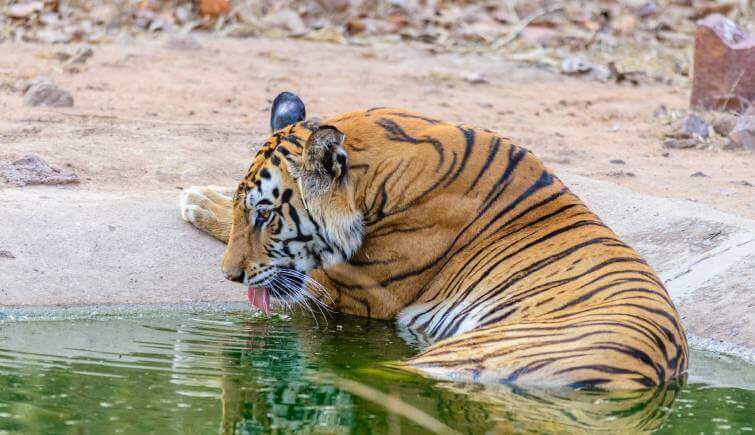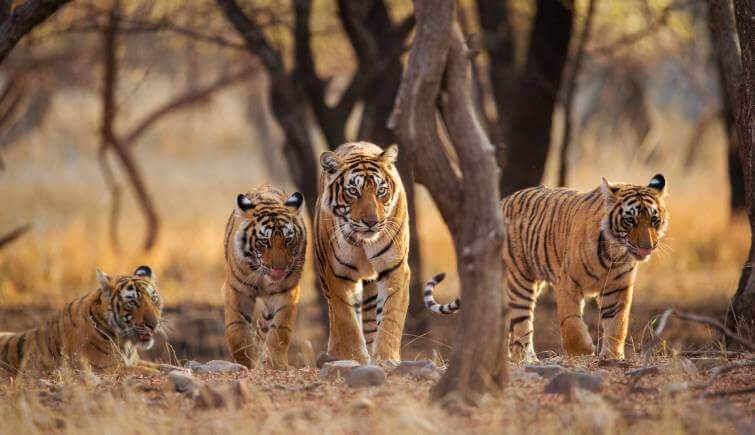
24 Jul, 2024
Why We Celebrate International Tiger Day: Exploring Its History and Importance
The World Celebrates International Tiger Day On 29th July, 2024
The rapidly advancing and globalising world will unite once more to commemorate International Tiger Day on July 29, 2024, also known as Global Tiger Day as a tribute to raising awareness for tiger conservation and its importance in the ecosystem. The preservation of these magnificent animals and their natural habitats is the primary objective of International Tiger Day.
Tigers, renowned for their power, grace, and appeal, are not just symbolic creatures but also vital to the preservation of ecosystem equilibrium. As apex predators, they control the amount of prey and contribute to maintaining the natural order of forests. Tigers are also referred to as "Umbrella Species" since many other species that share the same environment benefit from their conservation. To ensure a secure and prosperous home for tigers, humans must also safeguard other animals and forests.
People should endeavour to create a future in which tigers and humans can live in harmony by commemorating International Tiger Day. Moreover, tigers are frequently regarded as indicators of a healthy ecosystem; in other words, if tigers are doing well, then their habitats are probably doing well too. However, the need to know everything about International Tiger Day is well described in the upcoming sections.
History of International Tiger Day

The history of International Tiger Day or Global Tiger Day was first created in 2010 after it turned out that 97% of all tigers in the forests and wilds disappeared during the last century, with only about 3,000 living. This led the officials of nations bordering tigers to gather to discuss the drastic decrease in tiger populations as a result of poaching, habitat loss, and the illicit wildlife trade at the Saint Petersburg Tiger Summit in Russia in 2010. It has been widely reported that tigers are in danger of going extinct and hence the action led to the founding of International Tiger Day.
The meeting established the Tx2 target, which calls for doubling the wild tiger population by 2022. To engage governments, organisations, and people globally in tiger protection, International Tiger Day is essential.
The purpose of International Tiger Day is to prevent the tiger population from declining due to several issues, including habitat degradation, climate change, poaching, hunting and supporting environmentally friendly behaviours that benefit tigers and nearby populations. Thirteen nations, including China, Russia, and India, decided to cooperate in order to safeguard tigers. In addition to preserving these creatures, the day serves to protect and enhance their habitats. Global Tiger Day is also observed by several worldwide institutions, including the Smithsonian Institute, the IFAW, and the WWF.
Why is International Tiger Day Celebrated?

The question that often arises in the minds of intellectuals and curious souls is ‘Why is International Tiger Day Celebrated on July 29?’ Well, it is obvious that tigers were once on the verge of extinction and hence International Tiger Day is celebrated to raise awareness related to tiger conservation methods and reduce their declining numbers.
Global Tiger Day 2024 will seek to preserve and enhance tiger ecosystems while also increasing awareness of the significance of conservation towards different issues, such as habitat destruction, warming temperatures, hunting, and poaching, which have contributed to their decrease.
Importance of Tiger Conservation

International Tiger Day provides an opportunity to draw attention to international initiatives for tigers' preservation and protection all around the world by conveying the message to different communities, governments, conservation agencies, and wildlife enthusiasts to engage in a variety of events like seminars, workshops, and awareness campaigns.
The significance of International Tiger Day also shows how individuals can support tiger conservation initiatives in a variety of ways from different parts of the globe. Effective strategies to make a difference include boycotting items produced from endangered animals, supporting trustworthy conservation organisations, pushing for tougher laws protecting wildlife, and raising awareness on social media.
Tiger conservation is quite important as it is observed that around 95% of the tiger population declined in the 20th century due to several reasons despite conservation efforts. Consequently, tiger range countries decided to double the population of tigers by 2022 at the 2010 St. Petersburg Declaration. Therefore, conservation efforts are essential to guaranteeing that these amazing species can be appreciated in the wild by future generations.
Threats to Tiger Survival

Tigers are extremely endangered, despite their importance. They are seriously threatened by poaching, illegal wildlife trading, habitat destruction and other factors. The tiger regions are reportedly facing difficult circumstances because of the high rate of prey and tiger poaching, in addition to other shortcomings like insufficient patrols, inadequate wildlife monitoring, deforestation for commercial purposes, and rapid infrastructure development leading to fragmentation. Numerous interconnected aspects, primarily caused by human activity, are also linked to the fall in the tiger population listed below:
- Habitat Loss: The natural habitat of tigers has been greatly reduced as a result of the human conversion of forests into agricultural land, logging, growing urbanisation, and infrastructural development.
- Poaching: Humans illegally hunt for tiger body parts such as skin, bone, and teeth for trading reasons, disrupting the delicate balance of the tiger population. Tiger skins are often used in interior design. Additionally, bones are utilised in tonics and pharmaceuticals.
- Illegal Wildlife Trade: By selling and buying tigers as pets or for other amusement and business objectives, the illegal tiger trade takes advantage of the tigers' natural cycle of reproduction.
- Conflict between Humans and Wildlife: As human populations grow into tiger habitats, conflicts emerge because of livestock theft or dangers to human safety, which results in tigers being killed in retaliation.
- Climate change: Change in climate conditions is one of the main factors that has a significant effect on the number of tigers. The fragile ecosystems that tigers depend on are in danger due to rising sea levels and shifting weather patterns, which eventually impact their prey and habitats.
- Poor investment in Wildlife protection: The decline in tiger numbers can also be attributed to inadequate monitoring and poor funding for wildlife protection.
Current Tiger Population Worldwide

Roughly a million tigers lived in the wild at the start of the 20th century. However, as a result of human interference with poaching, the illicit wildlife trade, habitat damage, and other issues, their numbers have steadily decreased to 3,900. With the number of tigers at an all-time low of around 3,200 in 2010, the 13 nations that make up the tiger range set a worldwide aim to double the number of wild tigers by 2022, with assistance from conservation partners notably WWF. Currently, the Global Tiger Forum estimates that there are 5,574 wild tigers in the world. This latest figure, which shows a 74% rise since 2010, highlights notable improvements in the way we monitor and invest in tigers.
Given that the revised estimate brings tiger numbers even closer to the shared target of doubling tiger populations, this is an exceptional and exciting conservation triumph. The number of tigers in Bhutan, China, India, Nepal, and Russia has grown throughout the last 12 years. While certain regions see a rise in tiger populations due to successful tactics and exceptional commitment, the majority of tiger ranges and habitats continue to diminish.
All things considered, the tiger population has increased by 60 per cent, reaching 5,870. The situation in the Tiger Range Countries (TRCs) of Southeast Asia is "grim" due to the fall of tiger numbers in nations like Bhutan, Myanmar, Cambodia, Lao-PDR, and Vietnam. Effective habitat conservation and protection policies have been credited with the development of South Asian nations including Bangladesh, Bhutan, India, and Nepal, as well as China and Russia in North East Asia. As of 2022, there are 3,167 wild tigers in India. The number of tigers in Nepal has quadrupled.
International Tiger Day Successful Conservation Stories

Different nations around the world have different success stories related to tiger conservation. Several case studies demonstrate how well tiger population recovery programs have worked and how well the big cat population is thriving in the world.
- India: The success of the Project Tiger and the increasing number of Tiger Reserves are all shining examples of tiger conservation in India. Project Tiger was an innovative project that India started in 1973 to protect and grow the tiger population as well tiger reserves were created nationwide as a result of this campaign, offering tigers safe havens where they can breed. By enforcing stringent anti-poaching measures, restoring habitat, and involving the community, these reserves such as Corbett National Park and Bandhavgarh National Park along with Panna Tiger Reserves have played a crucial role in protecting tiger numbers.
- Nepal: With its dedication to conservation and community engagement, Nepal has seen a notable rise in the number of tigers. This achievement has been attributed to transboundary cooperation with India, strict anti-poaching tactics, and habitat restoration.
- Bhutan: With a reputation for enforcing conservation-focused regulations, Bhutan has successfully preserved tiger habitats and is currently home to a stable tiger population.
- Bangladesh: In order to save the endangered Royal Bengal tigers in the Sundarbans' mangrove forests, Bangladesh has also carried out programs like the Sundarbans Tiger Project.
- Indonesia: In an effort to stop poaching and the illicit wildlife trade, Indonesia, the country that is home to the critically endangered Sumatran tiger, has established national parks and strengthened law enforcement.
- Malaysia: Malaysia has made conservation efforts a priority, establishing wildlife corridors to improve tiger connectivity, as seen by the Belum-Temengor Forest Complex and Taman Negara National Park.
- Thailand: Thailand's tiger population has recovered in protected regions because of its extensive anti-poaching policies, habitat restoration efforts, and community involvement.
- South Africa: South Africa has effectively enacted policies to safeguard the tiger population in areas like the Kruger National Park. Initiatives to prevent poaching, the restoration of habitat, and cooperation between local communities and conservation groups have all been crucial to the tiger populations' recovery in this African nation.
Theme of International Tiger Day 2024: Call for Action
To save tigers and their habitats, coordinated effort is desperately needed, as shown by the theme of International Tiger Day 2024. For the current year, stakeholders are concentrating on strengthening enforcement against wildlife crime, growing protected areas, encouraging local populations to have sustainable means of subsistence, and educating the public about the predicament of tigers. Every year on this International Day, the phrase "Their future is in our hands" is used. The day was also declared in light of the worrying decrease in the number of wild tigers.
Interesting and Surprising Facts on Tigers

Some interesting facts about International Tiger Day that must to known are stated below:
- The biggest wild cat species worldwide are tigers.
- Each tiger has a unique stripe pattern of their own so it becomes easy for viewers to identify. The only other species of cat with all over striped coats is the tiger. No two tigers have the same body stripes. It's interesting to see that their shaved skin has the same pattern of stripes as their fur.
- Being solitary predators, the majority of tigers are nocturnal creatures.
- About half of the tiger cubs born are likely to survive, and all cubs are born blind.
- Tiger saliva has antibacterial properties. The creatures lick the region if they are injured in any way.
- The Siberian tiger, a subspecies of the larger cat species found worldwide, is the third biggest terrestrial carnivore and may reach a weight of 660 pounds. These magnificent animals are capable of travelling at around 40 mph.
- The term "tiger" comes from the ancient Persian word "taig," which means swift and keen. These big wild cats are easily recognised by their black stripes.
- An area of up to 386 square miles or 1000 square kilometres could potentially be considered a tiger's "turf." Tigers are carnivores that hunt smaller herbivorous creatures, just like other cats, and they play an important part in preserving ecological equilibrium.
- An adult tiger may devour up to 88 pounds of meat in one sitting. In the wild, they typically live between ten and fifteen years.
- Tigers can swim far and swiftly, allowing them to traverse rivers and cover large areas when hunting, unlike most other big cats. Even the young tigers like playing in the water, and the adults cool down in lakes or streams to avoid the heat.
Looking towards Future
On July 29, 2024, International Tiger Day, let us reaffirm our dedication to protecting these amazing animals. Together, we can make sure that tigers are free to roam the wild for many more generations, adding to the global efforts to conserve biodiversity and enhance our planet with their presence. By working together, we can ensure that tigers and our world have a better future.
Other Interesting Blogs to Read
- Best Places to Visit in Rajasthan
- Best Wildlife Resorts to Stay in Ranthambore
- Information Trinetra Ganesh Temple Ranthambore
- Ranthambore National Parks Latest News Updates
- Best Luxury Resorts in Ranthambore National Park
- Peacock Flying in Ranthambore National Park
- Take a Jungle Safari at These 10 Best Wildlife Destinations in Summer Season & Get the Best of Wildlife Adventure
- The Inspiring Story of How Aditya & Poonam Singh Made a Lush Forest Out of a Barren Land in Ranthambore
- Why Should We be Teaching Wildlife Conservation in Schools?
- Do’s and Don’ts of Staying Safe Around Wildlife
- Human – Wildlife Conflict in Concrete Jungle
- 20 Facts You Probably Didn’t Knew About Tigers
- Wildlife Conservation Initiatives by Indian Government
- Experience Golden Triangle India with Ranthambore Tiger Safari
- 10 Reasons to Visit Ranthambore Tiger Reserve in Rajasthan
- In Pictures: Showcasing India’s Endangered Species
- My Experience at Ranthambore National Park- Sundeep Kheria
- Top 5 Star Hotels in Ranthambore Tiger Reserve
- Photography Tour in Ranthambore National Park
- Rajiv Gandhi Regional Museum of Natural History












 Share
Share Home
Home Packages
Packages Book Now
Book Now